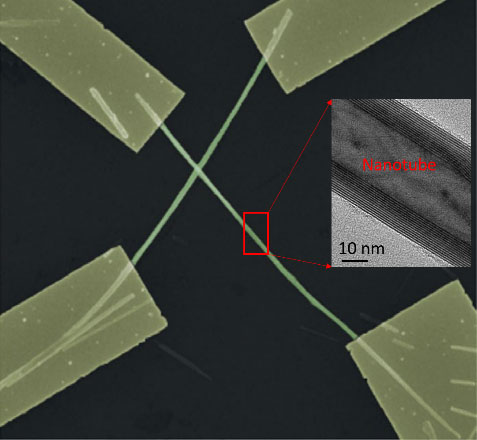| Feb 16, 2024 |
Five thousand atoms are all you need for ferroelectricity
(Nanowerk News) Ferroelectricity is a property of certain materials that creates a spontaneous or induced electric polarization of molecules, resulting in electric field inside the material. The polarization state can be permanent or reversed to opposite direction by the application of an external electric field.
|
|
Ferroelectric materials in the form of thin films or small crystals can be used for binary information storage and non-volatile (independent of energy source) memories. The smaller the ferroelectric crystal the larger the amount of memory units which can be introduced into the device, the quicker and more effective the device will work.
|
|
Nanomaterials, prepared in the laboratory of Prof. Zak, are semiconductor needle-like crystals ~60-100 nm in diameter and tens of microns in length, and have tubular shape.
|
|
Prof. Yao Guo, China, and Prof. Alla Zak, HIT, discovered ferroelectricity in these nanotubes, which allows to build fully operated artificial vision system based on these nanotubes solely. Artificial vision system allows recognition of the subjects using the sequence of actions such as sensing, memory and processing. Training of this device was done using machine learning.
|
|
The findings are published in Nature Communications ("0D van der Waals interfacial ferroelectricity") and Nature Electronics ("Ferroelectricity in zero dimensions").
|
 |
| An electron microscopy image of a zero-dimensional (0D) device formed at the interface of two crossed nanotubes. (Image: Courtesy of the researchers)
|
|
To reduce the size of the ferroelectric device, the scientists put one nanotube crossed another (as shown below), thus creating ferroelectric diode of size equal to the contact area between two tubes. This results in ferroelectric diode of point-size (~10 nm in diameter) and consisting of 5000 atoms only.
|
|
In their two groundbreaking articles, experimental evidence and theoretical simulations were provided which shattered the previously accepted notion that traditional ferroelectric effects were limited by the size of the atoms. With this discovery, the final piece of the ferroelectricity ‘puzzle’ was completed.
|
|
Ferroelectric effect is a physical phenomenon discovered in the early 20th century by Joseph Valasek. It provides an important technological pathway for information storage.
|
|
Prof. Alla Zak from HIT Holon Institute of Technology and Prof. Guo Yao from Beijing Institute of Technology explained: “Traditional ferroelectric effects is subject to size limitations, because when the size of ferroelectric crystals decreases, depolarization occurs and this can cause the original polarization, essential for ferroelectric effect, to disappear.”
|
|
This size limits the use of ferroelectric materials in high-density storage devices, meaning, the smaller the size of individual crystal, the larger the amount (the higher the density) that can be integrated into electronic-storage devices."
|
|
To address this challenge, Prof. Alla Zak , Prof. Guo Yao and collaborating researchers used two crossed tungsten disulfide nanotubes to construct ferroelectric diodes at the interface of their contact, which consists of only about 5000 atoms.
|
|
The researchers observed resistance changes and hysteresis phenomena typical to ferroelectric material in this nanoscale zero-dimensional device, thus demonstrating their ability to perform as a diode.
|
|
Through further experimental and theoretical verification, it was confirmed that the electrical behavior of the ferroelectric diode was due to the very gentle sliding inside the nanotube structure and over one.
|
|
"We are surprised that a 5000-atom interface system can produce such rich functionality”, commented Prof. Emeritus Reshef Tenne (Weizmann Institute, Israel), co-author of this study and recipient of the Materials Research Society’s prestigious Von Hippel Prize. Prof. Tenne believes that the downscaled ferroelectricity has important advantages for future high-density information storage, resulting in more efficient and faster performance. Moreover, this research is of great significance for size decrease of other ferroelectric devices such as sonar, fire sensors, and vibration sensors in the future.
|

